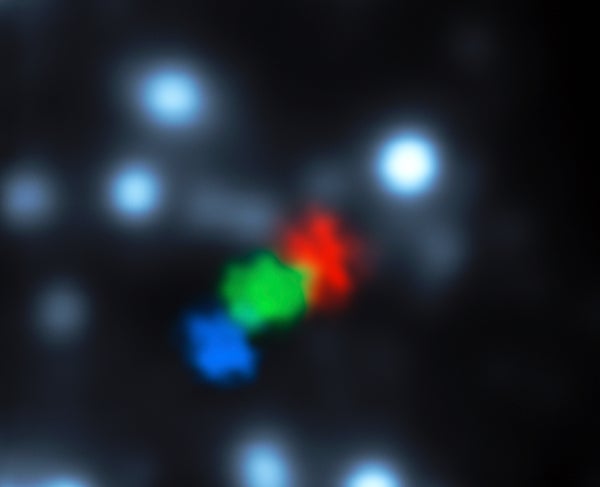This article was published in Scientific American’s former blog network and reflects the views of the author, not necessarily those of Scientific American
Last Tuesday, the weather at the Event Horizon Telescope (EHT) command center in Cambridge, Massachusetts couldn’t have been much worse: it was rainy and barely 40 degrees F. But that wasn’t important. What mattered were the conditions in Hawaii, Arizona, Spain, central Mexico, northern Chile, and at the South Pole. Was the weather good in all those places simultaneously? If so, they had a shot at imaging a black hole.
For this experiment, some 50 astronomers from around the world had traveled to high-frequency radio telescopes on four continents: ALMA and the Atacama Pathfinder Experiment in Chile; the Large Millimeter Telescope in Mexico; the Submillimeter Telescope in Arizona; the Submillimeter Array and the James Clerk Maxwell Telescope in Hawaii; the IRAM 30-meter telescope on Pico Veleta in Spain. A crew wintering over in Antarctica, whom EHT astronomers trained months earlier, would operate the South Pole Telescope. Using a technique called Very Long Baseline Interferometry, the astronomers would unite these geographically distant stations into a virtual Earth-size telescope capable of imaging the “shadow” that certain supermassive black holes cast against the glow of surrounding, superheated matter. A prime target is Sagittarius A*, the 4 million-solar-mass giant at the center of the Milky Way.
Earlier in the day, Shep Doeleman, the director of the EHT, gathered with a handful of colleagues to oversee the global effort here at the project’s command center, a modified faculty office at Harvard University’s Black Hole Initiative. Astronomers in the field checked in via phone, Slack, and Webex. They had until 4 pm local time to make the go/no-go decision.
On supporting science journalism
If you're enjoying this article, consider supporting our award-winning journalism by subscribing. By purchasing a subscription you are helping to ensure the future of impactful stories about the discoveries and ideas shaping our world today.
That night—the first of five opportunities in a ten-night window—the decision was straightforward.
The skies were clear in all the right places. At some sites, the weather could hardly have been better. It was almost as if the universe had decided the time was right to reveal this particular secret. “The tau is 0.07 at Mauna Kea, and it’s the middle of the afternoon,” said Shep Doeleman. “Tau” measures the optical depth of a medium—in this case, the Earth’s atmosphere. The higher a medium’s tau, the more opaque it is to starlight. “It just goes down from there,” as night approaches. “That doesn’t happen very often.”
“Twenty seconds until we hit,” said Jason SooHoo, an MIT Haystack Observatory technician who was remotely monitoring the data recorders at some of the sites.
Doeleman turned to SooHoo. “Count down from five.”
“Really?”
“Absolutely,” Doeleman said. “I want to hear it.”
“Okay,” SooHoo said. “Five. Four. Three. Two. One. Alright, things should be recording.”
And so the Event Horizon Telescope’s long-planned bid to directly image a black hole began.
The collaboration has been observing annually with smaller assemblages of telescopes since 2006, but this is the first year they have enough participating stations—and, thus, a powerful enough telescope array—to see actual images.
I’ve been following the EHT for five years, and it has been rare to see an observing campaign go smoothly. Things were different this week. Sure, there were technical glitches, but, as far we know, nothing catastrophic—no mechanical problems knocking a telescope out of commission for an entire night, no faulty cables or disk drives failing to capture data. And with the weather, they were just lucky.
To increase the chances that the astronomers get good weather at all sites, the participating telescopes allotted the EHT five nights to use over the course of 10 days. The weather was good enough at every site that the EHT observed the first three nights of the window consecutively. Such fortune is rare in observational astronomy. The team observed for so many hours during those three days, in fact, that by the end crew fatigue became a key limiting consideration. After taking two nights off to rest, troubleshoot some technical issues, and wait out some less-than-ideal weather, the team fired off another two consecutive nights, concluding this year’s campaign this morning, Tuesday, April 11—several days ahead of schedule.
The cruel irony of Very Long Baseline Interferometry is that the astronomers won’t know for months what their telescopes have seen. First, they must ship hard drives from all of the telescopes back to Haystack Observatory in Massachusetts and the Max Planck Institute for Radio Astronomy in Bonn, Germany. That will take some time; the South Pole Telescope’s hard drives are stuck in Antarctica until October, when the prohibitively harsh austral winter has ended and routine flights resume to and from the bottom of the world.
Next, the astronomers will feed data from those hard drives into supercomputers, pooling data gathered at all eight telescopes into a single, correlated set. If the data is good, those common detections will accumulate until images begin to emerge. Next, they’ll have to interpret those images. Have they seen what they expected to see, or something they don’t understand? After checking and rechecking their findings and interpretations, they’ll start the final stage: writing papers and submitting them for peer review.
That process could easily take a year. The results, however, could reverberate for much longer. As cool as it will be to have a pretty picture of a black hole, the details are important. The shape of the shadow, its size, its relation to the surrounding accretion disk, and other parameters might expose limitations of Einstein’s theory of general relativity, reveal deep secrets about the nature of spacetime, and help point the way toward a long-sought quantum theory of gravity. And no matter how smoothly the Event Horizon Telescope’s inaugural full-array observation might have gone, these are not secrets we should expect the universe to give up easily.
